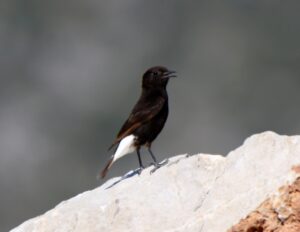Short note - A case of spatial coexistence among black wheatear Oenanthe leucura, black-eared wheatear Oenanthe hispanica and blue rock thrush Monticola solitarius in the western Mediterranean
Claudio Açaí Bracho Estévanez
Abstract:
The coexistence of similar species is determined by resource partitioning, while the exploitation of the same resource could lead to competitive exclusion scenarios. The breeding distribution of birds like the Black Wheatear (Oenanthe leucura), the Black-Eared Wheatear (Oenanthe hispanica) and the Blue Rock Thrush (Monticola solitarius) overlaps in open, rocky areas of the Western Mediterranean but so far, the degree of spatial segregation/overlap is poorly understood. Here, we used MAXENT to build species distribution models and investigate how the habitat preferences of those three species shape coexistence patterns in a coastal protected area of the Western Mediterranean. Within the study area the Black Wheatear is completely restricted to quarries with a predicted distribution of 162 ha. We found that the Black and Black-Eared Wheatears responded to a vegetation-vigour gradient that limits their interspecific territorial overlap (145.3 ha) to sunny slopes. The Blue Rock Thrush presence is mostly affected by slope gradient, although tolerating different vegetation-vigour levels, but overlapping with the Black Wheatear (32.1 ha) in quarry areas and with the Black-Eared Wheatear (62.8 ha) in steep, rocky slopes. Within the studied area, quarries appear as a key habitat favouring the coexistence of sympatric breeding species.
